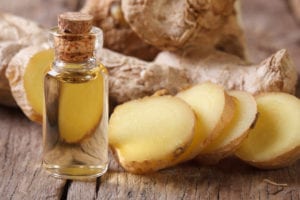Written by Greg Arnold, DC, CSCS. Two weeks of a combination of lemon and ginger oil aromatherapy significantly improved saliva production in the submandibular and parietal glands of participants undergoing radioactive iodine therapy.
 The incidence of thyroid cancer has been increasing worldwide over the past few decades. In the United States, almost 57,000 new cases of diagnosed thyroid cancer (DTC) will occur of which 74% are predicted to be women and of the ensuing deaths, over 2,000 (54%) will be women 1. Initial treatment for the majority of differentiated thyroid cancers (DTC) is complete removal of the thyroid 2. If the cancer returns, radioactive iodine therapy is an effective treatment that can “significantly improve the prognosis of recurrent thyroid cancer3.”
The incidence of thyroid cancer has been increasing worldwide over the past few decades. In the United States, almost 57,000 new cases of diagnosed thyroid cancer (DTC) will occur of which 74% are predicted to be women and of the ensuing deaths, over 2,000 (54%) will be women 1. Initial treatment for the majority of differentiated thyroid cancers (DTC) is complete removal of the thyroid 2. If the cancer returns, radioactive iodine therapy is an effective treatment that can “significantly improve the prognosis of recurrent thyroid cancer3.”
A side effect of iodine therapy is damage to the salivary glands (salivary gland dysfunction). This damage increases with increased numbers of therapies. Saliva secretion is important in that it helps flush out iodine that accumulates during iodine therapy and may lessen the degree of salivary gland damage and allow for further radioactive iodine treatment if needed 4.Saliva also lubricates the mucosa in the mouth, which allows for proper speaking, swallowing and tasting 5. When salivary gland function decreases, painful swelling of these glands may effect overall quality of life 6.
The aim of this study7 was to test the effectiveness of aromatherapy as a complementary intervention for decreasing salivary gland damage caused by radioactive iodine therapy.
Seventy-one patients (16 men, 55 women) between the ages of 35 and 78 and diagnosed with differentiated thyroid cancer were given aromatherapy treatment (n=35) or a placebo treatment (n=35) before each meal for a period of two weeks. The aromatherapy consisting of one milliliter of lemon blended with five microliters of ginger essential oils, was inhaled for ten minutes by the intervention group while those in the control group inhaled distilled water for10 minutes. Before and after the treatments, function of the two saliva producing glands in the mouth glands (parotid and submandibular glands) was measured by a method called scintigraphy (a technique in which a scintillation counter or similar detector is used with a radioactive tracer to obtain an image of a bodily organ or a record of its functioning).
After two weeks, aromatherapy significantly increased salivary gland function. Specifically:
- 56% increase in right submandibular gland function compared to 1.96% in the placebo group (p < 0.05)
- 91% increase in left submandibular gland function compared to 0.16% in the placebo group (p < 0.05)
- 31% increase in right parotid gland function compared to 4.66% in the placebo group (p < 0.05)
- 08% increase in left parotid gland function compared to 4.19% in the placebo group (p < 0.05)
RAI therapy showed increased saliva secretion after the inhalation of essential oils containing lemon and ginger. Researchers believe that lemon activates the parasympathetic and sympathetic nervous systems; therefore increasing saliva secretion. Saliva secretion may not only be the result of the autonomic nervous system action but may also occur through olfactory stimulation. When suggesting how aromatherapy improved salivary gland function, the researchers pointed to the ability of aromatherapy to stimulate the emotional part of the brain called the limbic system which can affect salivary gland function8 , while a component ginger called zingiberene is known to promote salivary gland secretion. They conclude “our results suggest the efficacy of aromatherapy in the prevention of treatment-related salivary gland disorder.”
Source: Nakayama, Michihiro, Atsutaka Okizaki, and Koji Takahashi. “A Randomized Controlled Trial for the Effectiveness of Aromatherapy in Decreasing Salivary Gland Damage following Radioactive Iodine Therapy for Differentiated Thyroid Cancer.” BioMed research international 2016 (2016).
© 2016 Michihiro Nakayama et al. This is an open access article distributed under the Creative Commons Attribution License, which permits unrestricted use, distribution, and reproduction in any medium, provided the original work is properly cited.
Click here to read the full text study.
Posted October 23, 2017.
References:
- Society TAC. Key Statistics for Thyroid Cancer. 2017; thyroid cancer statistics. Available at: https://www.cancer.org/cancer/thyroid-cancer/about/key-statistics.html. Accessed October 15, 2017.
- Carvalho MR, Ferreira TC, Leite V. Evaluation of whole-body retention of iodine-131 (131I) after postoperative remnant ablation for differentiated thyroid carcinoma–thyroxine withdrawal versus rhTSH administration: A retrospective comparison. Oncology letters. 2012;3(3):617-620.
- Mazzaferri EL, Jhiang SM. Long-term impact of initial surgical and medical therapy on papillary and follicular thyroid cancer. The American journal of medicine. 1994;97(5):418-428.
- Kim YM, Choi JS, Hong SB, Hyun IY, Lim JY. Salivary gland function after sialendoscopy for treatment of chronic radioiodine‐induced sialadenitis. Head & neck. 2016;38(1):51-58.
- Almeida JP, Sanabria AE, Lima ENP, Kowalski LP. Late side effects of radioactive iodine on salivary gland function in patients with thyroid cancer. Head & neck. 2011;33(5):686-690.
- Mandel SJ, Mandel L. Radioactive iodine and the salivary glands. Thyroid. 2003;13(3):265-271.
- Nakayama M, Okizaki A, Takahashi K. A Randomized Controlled Trial for the Effectiveness of Aromatherapy in Decreasing Salivary Gland Damage following Radioactive Iodine Therapy for Differentiated Thyroid Cancer. BioMed research international. 2016;2016.
- Matsumoto T, Asakura H, Hayashi T. Effects of olfactory stimulation from the fragrance of the Japanese citrus fruit yuzu (Citrus junos Sieb. ex Tanaka) on mood states and salivary chromogranin A as an endocrinologic stress marker. The Journal of Alternative and Complementary Medicine. 2014;20(6):500-506.

